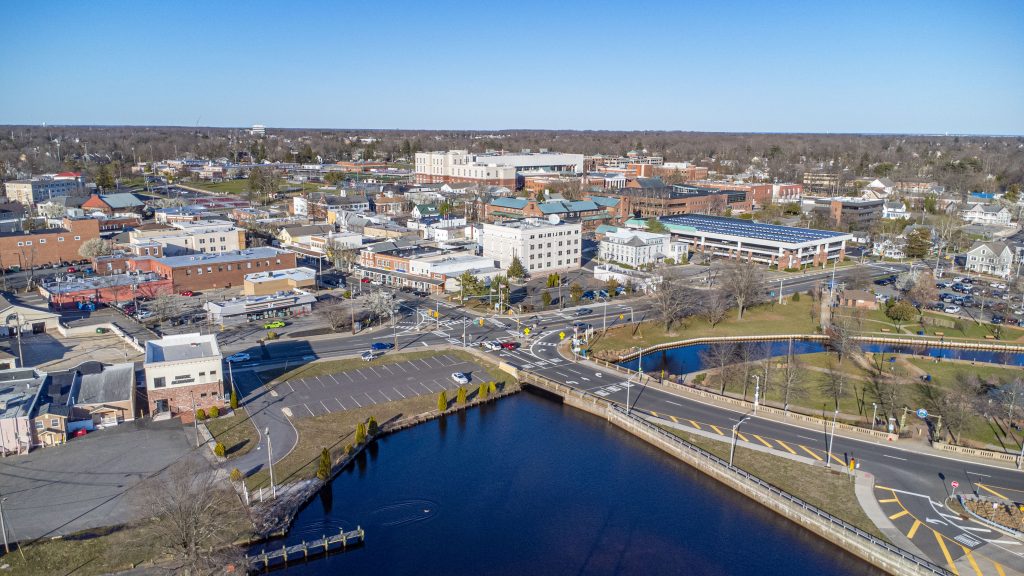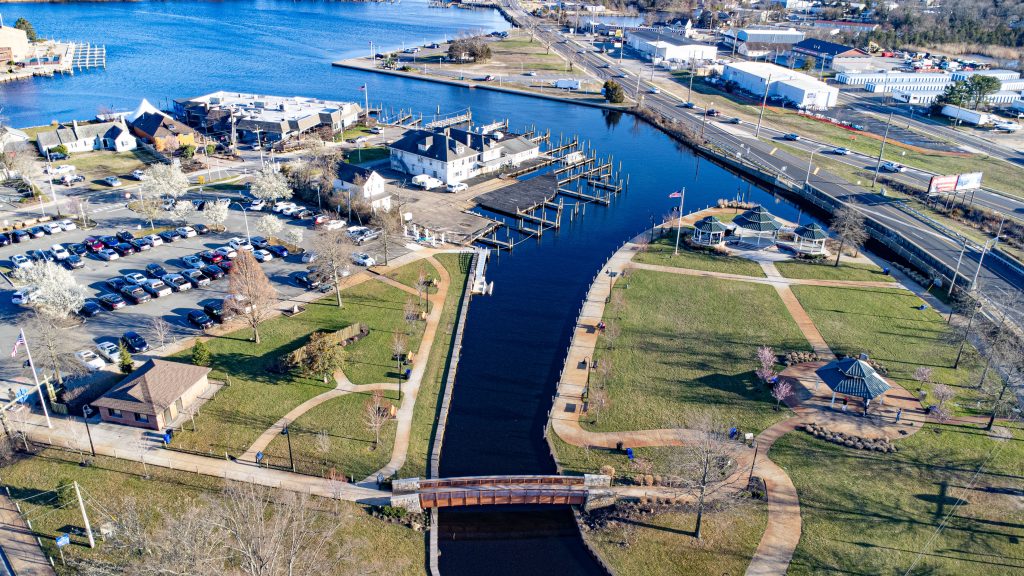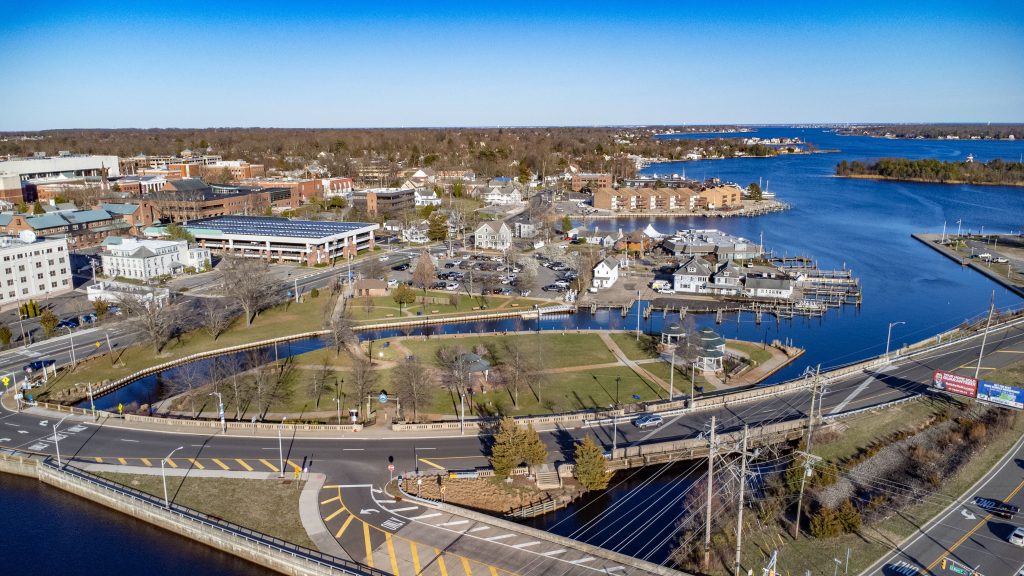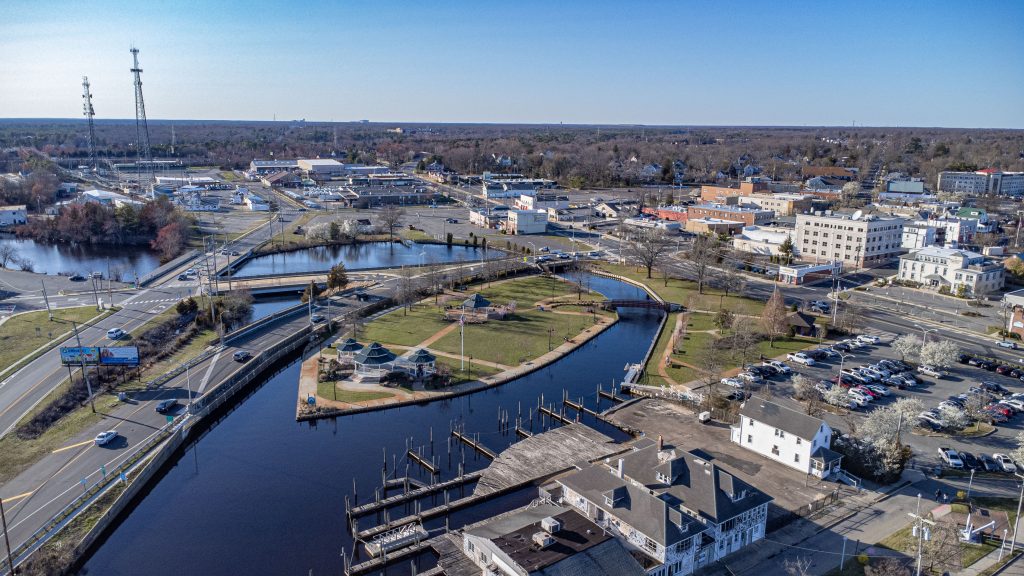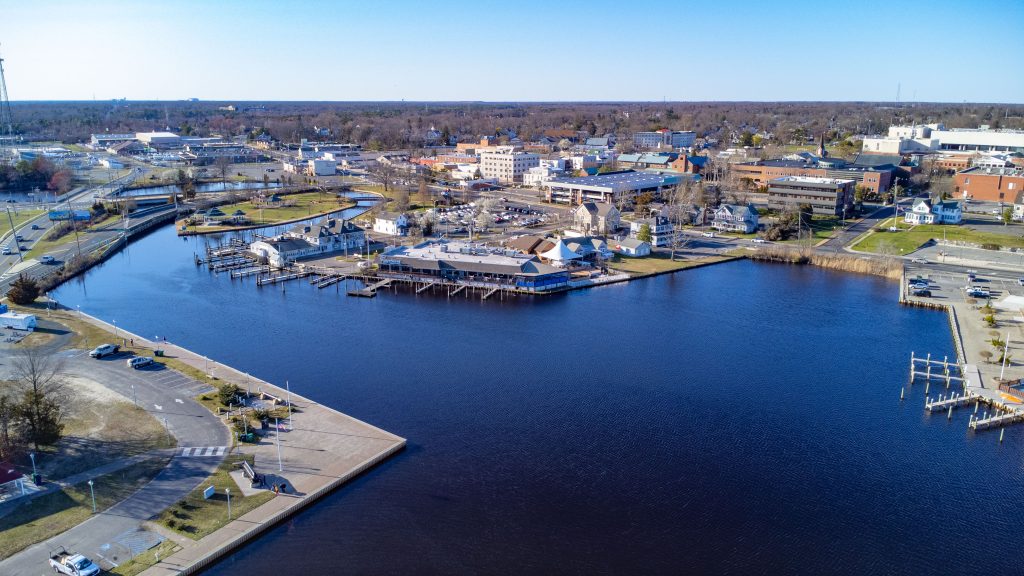With a contentious election looming later this year, the fate of the future of Toms River is being debated where its past thrived: downtown.
Earlier this month, the township council held off on a vote that would extend the designation of Capodagli Property Company as the redeveloper for the former Boatworks facility, a weather-beaten building across the street from the Water Street Bar and Grill on Robbins Parkway, and the adjacent land parcels. Since the vote, and with candidates for the two major parties’ primary elections having officially registered, the internet has been flooded with images, memes and Photoshops by factions of each side that have split the community.
Meanwhile, many residents would be forgiven if they were confused by the delayed vote, what it means, and whether it has any affect on the mixed-use waterfront high-rise buildings that have been the focus of the bulk of the controversy of downtown development. The final question is answered relatively easily: the ten-story, twin-building complex which will replace the former Red Carpet Inn motel has already received planning board approval and construction is expected to begin later this spring or in the summer. Capodagli, based in Linden, is the redeveloper for that project.
The vote earlier this month has no affect on the project, which has received heaps of praise from some residents and members of the business community alongside derision from those who maintain the tall buildings will change the character of Toms River from its “small town” suburban image to a bustling small city. For Mayor Maurice “Mo” Hill, the issue of downtown redevelopment – though it had been discussed for years before he became mayor – quickly rose to the top of election issues as he seeks a second term. But while the high-rise buildings are already on their way, a great many aspects of downtown redevelopment have still yet to be decided, with emotionally-charged opinions on how to move forward emanating from all sides.
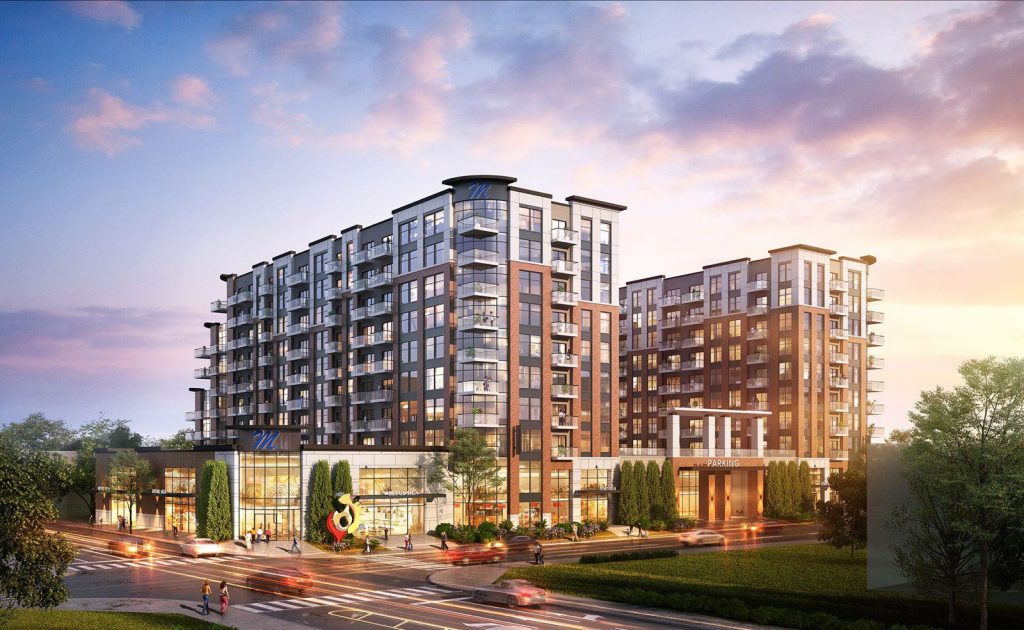
A proposed mixed-use redevelopment project proposed for Water Street in downtown Toms River. (Photo: Toms River Township)
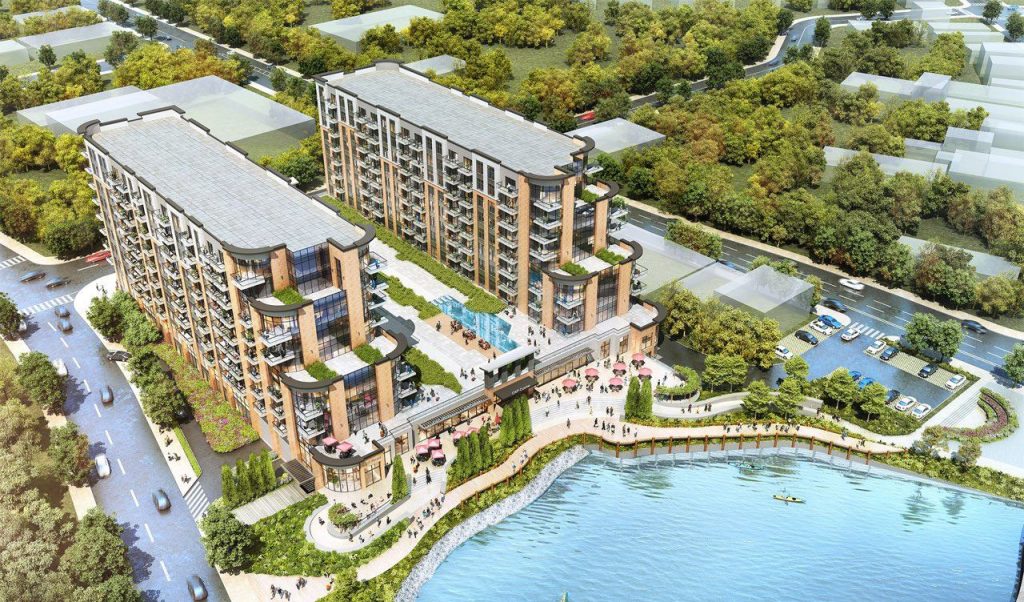
A proposed mixed-use redevelopment project proposed for Water Street in downtown Toms River. (Photo: Toms River Township)
Last month’s vote to hold off on re-designating Capodagli as the declared redeveloper of the Boatworks property came after speech delivered at the council meeting by a man who has worn many hats in Toms River. Mark Mutter, who at one time or another covered Toms River as a reporter, practiced in town as an attorney, served as mayor, served as township clerk, and continues to serve in retirement as the township historian, told the current governing body that he was opposed to the redevelopment plans as currently proposed.
The downtown area “has character, it has personality, and it has history,” Mutter said.
“Those towers, if they get built, will rival the height of the Barnegat Lighthouse,” he said. “They will be able to be seen from the Garden State Parkway. They will give Toms River a skyline – and they will change the village of Toms River into the city of Toms River.”
If the town is to move forward in developing itself as a valuable destination, however, trends cannot be ignored, Hill told Shorebeat.
“Any town that has gone through redevelopment has gone vertical,” he said. “In Red Bank, if you go a block away from the Molly Pitcher on the Navesink, there are two 12-story apartment buildings.”
Long Branch, once crime-ridden and dilapidated, is now a high-end destination with its high-rise towers, and next door in Seaside Heights, a ten story building will replace what came to be known as the “steel structure,” a hulking mess of rusting steel that at one time was slated to become a nightclub and entertainment complex. Along the Boulevard, buildings between four and seven stories have been proposed, and are slowly-but-surely receiving approvals and construction getting underway.
Toms River is already the eighth-largest municipality in New Jersey, Hill said.
“It’s not a small village, and I don’t think you can go back there,” he said. “We’d all like to go back to the way things were in our childhood, but it’s just not realistic.”
Millennials and Gen-Z residents, groups that are now moving on from living at home or with roommates, are seeking vibrant places to call home. Studies show they tend to prefer close-by entertainment options like nightlife and restaurants, they are often choosing not to have children until later in life, and do not look as fondly on suburban sprawl as their parents and grandparents did when they left the cities in decades past. In a certain way, supporters argue, reviving the downtown area of Toms River could bring back the importance of the area to the community.
“Back when I was in high school, Toms River had maybe 16,000 people and everyone shopped downtown,” recalled Hill. “You had a soda shop, small grocery stores, the community theater on Washington Street, but once the mall came those stores dried up.”
Redevelopment could lead the downtown loop into an era of renewal, as an influx of residents who want to play where they live will demand restaurants, entertainment and nightlife. Potential changes to the state’s liquor licensing laws could also give the downtown sector an edge over the massive chain restaurants which used their financial backing to scoop up previous licenses, effectively denying Toms River a diverse restaurant scene.
“I think we need people living downtown for it to be a vital area,” said Hill. “And you need people who are willing to walk to a restaurant, a brewery, the distillery. I would look for different types of restaurants, a Mexican restaurant, Thai, Indian – a mixed bag, so people have a choice.”
It is expected that the mixed-use towers will primarily house young residents and some empty-nesters, along with boaters who may choose to live seasonally in town, just up-river from the Intracoastal Waterway. Much of the remainder of downtown redevelopment, however, remains in flux.
At issue with the March 22 vote (or lack thereof) is the Boatworks complex. According to Hill, Capodagli’s conceptual plans, which have yet to evolve into actual proposals, include two restaurants that would overlay the existing building. A banquet hall would be built on what is now a surface parking lot next door, and parking would be expanded elsewhere to compensate. The area that currently makes up Huddy Park is also part of the redevelopment plan that has not yet seen formal proposals. The area where the park currently stands could be at least partially developed, though the overall plan calls for public waterway access and a greenway that will run from the park to the Garden State Parkway, plus incorporate accessible means to cross over to more open space in South Toms River.
Mutter, in his address to the council, criticized the overall development plan, telling officials it was not well planned and incohesive.
“In my judgment, the future of Toms River can be handled in a better way,” he said. “So far, it’s being done in a piecemeal fashion, project-by-project and resolution-by-resolution. Two ten-story apartments over here, a project on Irons Street over there, and a third project over here.”
Mutter suggested convening an open, township-wide summit on redevelopment that would allow residents to share ideas and concerns before more projects are approved.
“In 2000, when I served as mayor, as I took office in this room I proposed an open-space tax for the preservation of land in our town,” he said, describing an idea that initially was very unpopular. “Hundreds of acres have been preserved, and we might take it for granted today, but getting it passed was no easy task. As mayor, I decided to convene an open space summit to discuss the tax idea and other issues.”
In the end, residents ended up supporting an even higher open space tax of 1.5-cents, passed by a wide margin.
“The vote, despite the naysayers, wasn’t even close – 71 percent yes,” he recalled. “Even Ortley Beach, which has no open space except for the beach, voted yes. The point is that something good for Toms River came out of that broad, thoughtful discussion.”
Mutter said two such summits were held on the open space issue, drawing more than 200 residents each time. The same, he argues, should be done to discuss downtown redevelopment.
“There is widespread concern, even astonishment, as to what has been approved so far,” he said.
Hill, for his part, said Mutter was invited to attend meetings with the redeveloper but declined to do so. He also said Capodagli has been responsive to calls from residents and some township organizations to provide open space in their eventual proposal, and maintain the downtown area’s historical themes of boat-building and nautical industry.
“There’s nothing proposed and nothing before the planning board yet,” said Hill. “They’ve been meeting with the historical society and they were amenable to incorporating some of what they’ve been concerned about into the project.”
Mutter’s address to the council ended with cheers from many in the room, including council members Dan Rodrick and Justin Lamb, both of whom have run for office on anti-overdevelopment platforms. Rodrick is among several candidates seeking the Republican nomination to run for mayor, opposing Hill, who leads a different GOP faction.
“Since being elected to town council in 2017, I have voted against every new development, including Mayor Hill’s plan to build two 10-story apartment buildings downtown,” he said in a statement announcing his campaign, adding that Hill is “destroying Toms River” and fellow GOP rival Geri Ambrosio and other candidates “are backed by the same special interests who backed Mo Hill.”
Hill pushed back against the idea that the downtown area is being “overdeveloped,” specifically citing language that has described “Lakewood-style” overdevelopment, driven largely by religious schools, sprawling blocks of two-story multifamily housing units and some industrial facilities. Toms River’s redevelopment, by contrast, is taking place in designated areas with a specific goal of revitalizing the downtown. He said he does not expect any other proposals to include buildings as large as the already-approved towers.
“There is nothing approved for the Boatworks, and they’re looking at something smaller near Irons Street, which would be about four stories,” Hill said.
Many of the residents of the downtown area are expected to be employees of OceanFirst Bank’s new corporate headquarters that is under construction, a large Veterans Administration outpatient facility approved for Hooper Avenue, and a quickly-expanding residency program at Community Medical Center, which itself is preparing for significant growth over the coming decades. A mixed-use downtown consisting of residential dwellings and commercial space would provide the cohesive neighborhood many seek, he said.
“If somebody rolls off a 12-hour shift at the hospital and it’s 6 a.m., they’re going to look for a place that’s serving breakfast,” he said, and perhaps make plans for dinner that night.
“My job is to represent the best interests of the people in Toms River, and I rest my head on the pillow every night knowing I’m doing that,” Hill said.
Mutter also said his heart is in the right place when expressing his criticism of the redevelopment process thus far.
“Convene a Downtown Toms River Summit, and let’s all have a thoughtful discussion about the future of our town,” he said. “The future of our downtown is at stake.”
Though the township council will meet Wednesday night, the governing body has already announced that it will reconsider the renewed designation of Capodagli as redeveloper for the Boatworks phase of the effort at the April 26 meeting, which provides more time to solicit feedback, and when more residents will be home from spring vacations.
There has not yet been an announcement as to whether or not the township will host a summit meeting as proposed by Mutter.


Police, Fire & Courts
Toms River Man Sentenced to Prison for Assault, Eluding, Robbery, Threats

